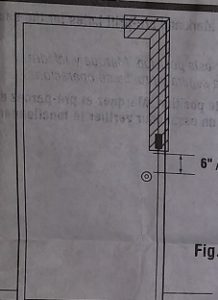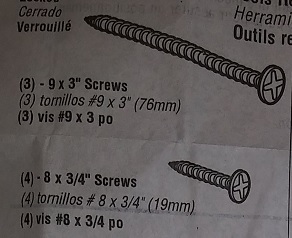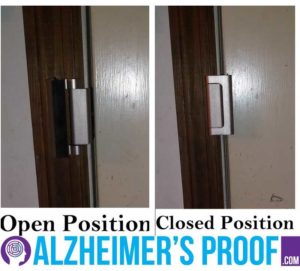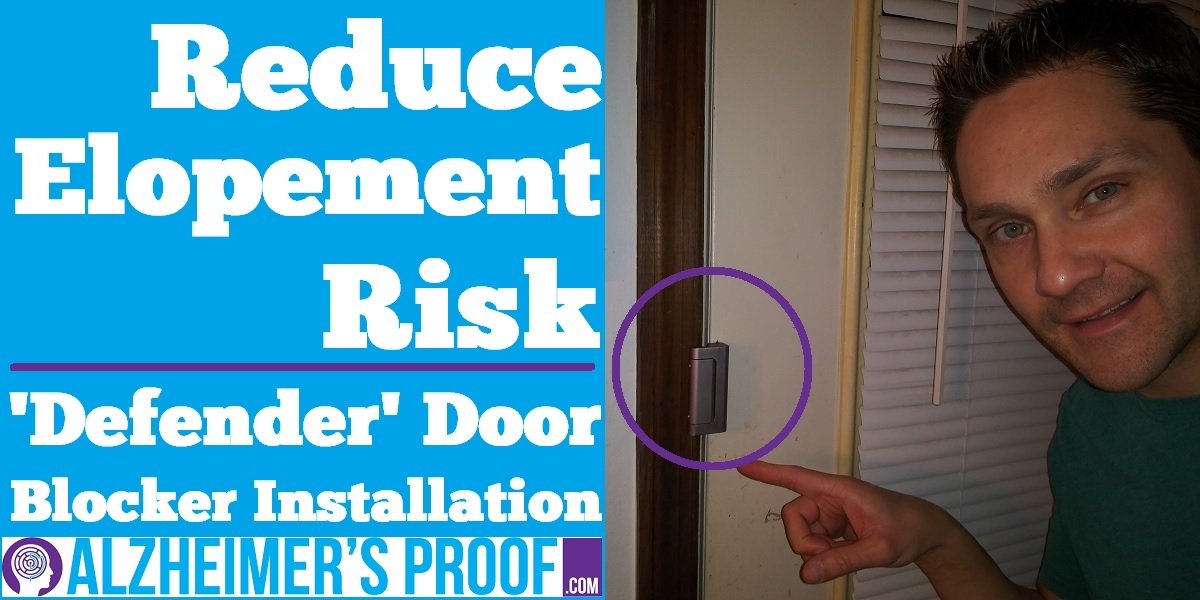One of the major challenges in caring for someone who has Alzheimer’s Disease, or some other form of dementia, is that they are often prone to “elopement.” Of course, in the context of long-term care, elopement has nothing to do with illicit or surreptitious marriage. It has to do with a cognitively impaired person leaving the safety of the care environment without supervision.
This problem can be extremely vexing for the caregiver and perilous for the Alzheimer’s sufferer. I know this firsthand. On one memorable occasion, my dad was returned to his home by a police officer after he had been found wandering along a busy road in our city. During a snowstorm.
However, I was able to hinder my dad from wandering with an ingenious little gadget. In this article, I’m going to explain how to install that device – a door blocker called the “Defender.”[1] I have installed several of these blockers: one in an apartment, and a couple of them in a townhouse. I absolutely love these products. And I think that you might, too.
Introduction
What’s the Function of the ‘Defender’?
Knowing your loved one can open doors and leave the care environment without you or a caretaker in tow – or even realizing your charge is gone – is a terrifying proposition. Memory and reasoning deficits raise the possibility that he or she could become disoriented and lost, or even injured or worse.
From the perspective of long-term home care, then, the main benefit of these locks is to prevent your loved one from eloping. The devices are inexpensive, and the contemplated modification may be performed relatively easily.
This sort of change is part of what I mean by “Alzheimer’s proofing” your home environment. (This is a concept that I describe more fully HERE.) Under this way of using the phrase, it is a close cousin to childproofing a house as expectant parents would do in preparation for the arrival of a newborn.
Devices Double as Theft Deterrents
These door blockers can deter Alzheimer’s sufferers, or other cognitively disabled persons, from opening exit doors, leaving the care environment, and potentially putting themselves in harm’s way.
But it is worth noting that this particular use – keeping someone inside the house – is a bit of a departure from the product’s stated purpose.
This style of door lock has been designed and marketed as a security device and theft deterrent. When properly installed on an entrance door, the lock helps to prevent forcible entry into a house. It essentially fortifies the door so that even if a thief has jimmied it, or defeated its deadbolt and locking mechanisms, the door blocker will enable the door to remain in a closed position.
So, beyond the standpoint of Alzheimer’s proofing, it will add another layer of security to your home.
Can Your Alzheimer’s-Afflicted Loved One Defeat the Blocker?
As stated, the Defender is intended to be set into a locked position inside the home in order to reduce the probability of forcible entry should an intruder attempt to gain access to the interior of your house.
Given this, it has been designed to be locked and unlocked by normal-functioning adults. Therefore, it is possible for a cognitively impaired person to operate the latch. However, to do so he or she would have to have a number of cognitive and physical abilities. A rough-and-ready enumeration of these might look the following.
Cognitive Abilities Plausibly Needed to Defeat the Blocker:
- The ability to notice the device
- The capability to identify its function
- The capacity to understand or the resourcefulness to determine the correct way to unlock it once
- The motor skill and dexterity required to execute the unlocking action
- The memory power to remember how to defeat it on subsequent encounters
I’m certainly no medical or psychological expert. But, the likelihood that a cognitively impaired individual would possess this collection of abilities seems to me to be somewhat low. More guardedly, I suppose that I would venture the opinion that the probability is low at least once your loved is sufficiently advanced in his or her dementia to be a serious elopement risk.
Often, if it is positioned high enough on the door – or if it is camouflaged – your loved one may not even recognize that the door blocker has been installed. Of course, this is because Alzheimer’s tends to diminish perception. In the case of my dad, for instance, I don’t believe he noticed that the thing was even there.
Additionally, a high-up position might hinder the door-opening ability of a senior adult in general – quite apart from any dementia – for example if he or she has joint or mobility issues.
Moreover, the door blocker requires an additional motion, outside of those used to open doors in the usual way, that may frustrate a person with a cognitive deficit and prevent them from eloping from the home.
WARNING!
I should, however, inject an important word of caution.
These door blockers may hinder your and your loved one’s abilities to exit the house in the event of a fire or other emergency. If you’re going to use these products as a deterrent to help prevent elopement of a loved one from the residence, you may want to ensure the blocker is activated only during the time periods where your loved one is at the highest risk of vacating the premises without you noticing.
Of course, from a theft-deterrence perspective, it is appealing to have the latch activated throughout the night or during whatever intervals occupants of the house wish to lower the likelihood of intrusion.[2]
Disclaimer:
I cannot advise you as to the appropriateness of any particular course of action for your application. Furthermore, I cannot be sure, and do not warrant, that the device will be effective for you – for any purpose whatsoever. This information is presented as-is, for general or entertainment purposes only. Whatever use you put this information to is entirely your own responsibility. No one at or affiliated or associated with AlzheimersProof.com assumes any liability for how you may implement or not implement any of the ideas described in on this website or in any companion videos.
Be aware of where and under what circumstances you are installing these blockers. The upshot is that I am certainly not guaranteeing that these devices or installation methods will be successful or safe for your individual or family situation.
I can only state that these blockers were a tremendous help for me and my family when caring for my Alzheimer’s-afflicted dad.
My Installation Procedure
‘Unboxing’ & Collecting Required Tools

Upon opening the Defender’s packaging, you will find several items. These include:
- The door blocker device itself;
- Instructions;
- 3 large wood screws;
- 4 smaller metal screws;
Tools
The main tools needed include:
- A drill (this could be theoretically be corded or cordless; mine was the latter)
- 1/8-inch drill bit
- Philip’s screwdriver
Optional (& Possibly Necessary) Tools
- Wood chisel (if there is insufficient space in between the door and door jamb to accommodate the blocker)
- Hammer (to use the chisel, if one is needed)
- Center Punch (to tap a small “pilot” for the drill bit)
- Tape Measure (to assist in positioning the blocker on the door with respect to the other locking hardware – such as doorknobs and deadbolts)
Safety Equipment
- Safety goggles
Positioning the Blocker
You may want to begin by determining where you want to place the Defender door blocker. The instructions suggest that it be installed at least 6 inches above the door handle and deadbolt.
As suggested above, it may be beneficial to install this blocker a bit higher than this. In fact, there is an “L-shaped” area on the door within which the manufacturer recommends placing the Defender.

While determining where to install the blocker, place the blocker in the locked position. While in this fully closed position, slide the plate between the door frame and door with the black pad against the door.
This will allow you to get a good look at everything, and to reposition the blocker is desired or necessary.
**Be mindful of any electrical outlets nearby as there may be wiring within the walls near where you may be drilling. Additionally, look at surrounding door hardware, molding, key hooks, or other things that might interfere with your ability to operate the blocker and allow it to swing fully from locked to unlocked positions, and back again.
Actual Installation Steps
Step One
Once you have determined where you want to place the door blocker, use a pencil to mark the placement of the center screw within the door frame.
Step Two
Use your drill and 1/8-inch drill bit to make a hole where the center screw will be placed.
Step Three
Place the door blocker plate back against the door frame, allowing the recently drilled hole drilled to be visible in the center-hole of the plate.
Step Four
Drive the center screw into the door frame allowing the blocker plate to be provisionally positioned. The center hole is oval shaped and allows for the back-and-forth movement of the device in order to ensure that it is tight enough against the door to perform its function, but not so tight that it prevents you from latching and unlatching it.
Step Five
Test for the appropriate and desired fit. Before fully securing the door blocker, close the door and test the blocker in the locked position to ensure the placement is optimal. If the lock is difficult to engage or disengage, the placement of the plate may need to be adjusted slightly for proper operation of the device. In this case, you would simply loosen (but not remove) the center screw, move the blocker, and re-tighten the screw.
Step Six
Once the positioning has been established, ensure that the center screw is fully tightened – but not over-torqued. (You don’t want to strip the head or threads.)

Then, drive in the remaining three (3) screws – large screws for a wooden door frame; small screws for metal – into the remaining holes present on the door blocker plate to firmly secure the blocker.
Congratulations!
Your Defender door blocker has now been successfully installed!

If you need an additional assist, or a bit more in the way of visual aids, never fear. For a demonstration of the operation of the lock, or for a video tutorial on the installation procedure, please view my companion YouTube video: Alzheimer’s Elopement & Access Control: Install the Defender Door Lock.
Thank you for reading! I wish you all the best trying to deal with elopement risk.
Notes:
[1] The “Defender” appears to me to be an off-brand version of a different door blocker known as the “Door Guardian.” I also have the Door Guardian and will walk through its – nearly identical – installation procedure in a subsequent post.
[2] Note that there is no “key” and that the device is not designed to be unlocked from the outside. It is supposed to be activated and deactivated from within the area being secured.

